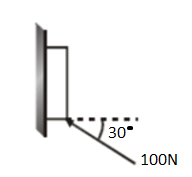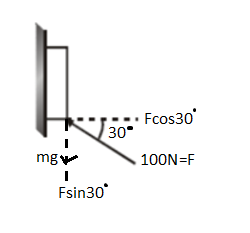
A force of \[100N\] is applied on a block of mass \[3kg\] as shown in figure. The coefficient of friction between the surface of the block is\[0.25\] . The friction force acting on acting on the block is:

A) \[15N\] downwards
B) \[25N\] upwards
C) \[20N\] downloads
D) \[20N\] upwards
Answer
218.1k+ views
Hint: In this question, we have to first resolve the components of \[F = 100N\]. After resolving the components, we can find the net force on the block. We can find the limiting force between the block and the surface by using the formula ${F_l} = \mu F\cos {30^ \circ }$. After comparing the net force and the limiting force, we can find the friction force acting on the block.
Complete step by step solution:
According to the question, we have a block of mass \[m = 3kg\]. A force of \[F = 100N\]is applied on the block. Now, resolving the components of the force \[F = 100N\], we get the components according to the following figure.

Both components $mg\sin {30^ \circ }$ and $mg\cos {30^ \circ }$ works towards the block. So, $mg\sin {30^ \circ }$works upwards on the block. The weight of the block of $mg$ works downwards on the block. So, net force ${f_a}$ will be given as-
${f_a} = F\sin {30^ \circ } - mg$
Now, substituting the values of force (\[F = 100N\]) , \[sin{30^ \circ } = \dfrac{1}{2}\] , \[m = 3kg\]and \[g = 10\] in the above equation, we get-
\[
{f_a} = 100 \times \dfrac{1}{2} - 3 \times 10 \\
{f_a} = 50 - 30 \\
{f_a} = 20N \\
\]
This net force is directed upwards on the block.
Now, the limiting friction${F_l}$ between the surface and the block will be given as
${F_l} = \mu F$
Substituting the value of \[F = F\cos {30^ \circ }\]and $\mu = 0.25 = \dfrac{1}{4}$ in the above equation, we get-
$
{F_l} = \mu F\cos {30^ \circ } \\
{F_l} = \dfrac{1}{4} \times 100 \times \dfrac{{\sqrt 3 }}{2} \\
{F_l} = 25 \times 0.866 \\
{F_l} = 21.65N \\
$
The limiting friction is greater than the net force on the block. So, the block will not slip.
So,
${f_r} = {f_a} = 20N$
Hence the friction force acting on the block is equal to \[20N\]and it is directed upwards.
Therefore, option D is correct.
Note: We have to keep in mind that the force is acting towards the block. So, both the components will also be directed towards the block i.e. vertical component is directed upwards. If the limiting friction is greater than the net force then the net force is equal to the friction force acting between the block and surface.
Complete step by step solution:
According to the question, we have a block of mass \[m = 3kg\]. A force of \[F = 100N\]is applied on the block. Now, resolving the components of the force \[F = 100N\], we get the components according to the following figure.

Both components $mg\sin {30^ \circ }$ and $mg\cos {30^ \circ }$ works towards the block. So, $mg\sin {30^ \circ }$works upwards on the block. The weight of the block of $mg$ works downwards on the block. So, net force ${f_a}$ will be given as-
${f_a} = F\sin {30^ \circ } - mg$
Now, substituting the values of force (\[F = 100N\]) , \[sin{30^ \circ } = \dfrac{1}{2}\] , \[m = 3kg\]and \[g = 10\] in the above equation, we get-
\[
{f_a} = 100 \times \dfrac{1}{2} - 3 \times 10 \\
{f_a} = 50 - 30 \\
{f_a} = 20N \\
\]
This net force is directed upwards on the block.
Now, the limiting friction${F_l}$ between the surface and the block will be given as
${F_l} = \mu F$
Substituting the value of \[F = F\cos {30^ \circ }\]and $\mu = 0.25 = \dfrac{1}{4}$ in the above equation, we get-
$
{F_l} = \mu F\cos {30^ \circ } \\
{F_l} = \dfrac{1}{4} \times 100 \times \dfrac{{\sqrt 3 }}{2} \\
{F_l} = 25 \times 0.866 \\
{F_l} = 21.65N \\
$
The limiting friction is greater than the net force on the block. So, the block will not slip.
So,
${f_r} = {f_a} = 20N$
Hence the friction force acting on the block is equal to \[20N\]and it is directed upwards.
Therefore, option D is correct.
Note: We have to keep in mind that the force is acting towards the block. So, both the components will also be directed towards the block i.e. vertical component is directed upwards. If the limiting friction is greater than the net force then the net force is equal to the friction force acting between the block and surface.
Recently Updated Pages
Arithmetic, Geometric & Harmonic Progressions Explained

Cartesian Form of Vector Explained: Formula, Examples & Uses

Apparent Frequency Explained: Formula, Uses & Examples

Calorimetry: Definition, Principles & Calculations

Centrifugal Force Explained: Definition, Formula & Examples

Charge in a Magnetic Field: Definition, Formula & Examples

Trending doubts
JEE Main 2026: Application Form Open, Exam Dates, Syllabus, Eligibility & Question Papers

Derivation of Equation of Trajectory Explained for Students

Hybridisation in Chemistry – Concept, Types & Applications

Understanding the Angle of Deviation in a Prism

Understanding Collisions: Types and Examples for Students

Understanding Atomic Structure for Beginners

Other Pages
JEE Advanced Marks vs Ranks 2025: Understanding Category-wise Qualifying Marks and Previous Year Cut-offs

Units And Measurements Class 11 Physics Chapter 1 CBSE Notes - 2025-26

NCERT Solutions For Class 11 Physics Chapter 8 Mechanical Properties Of Solids

Motion in a Straight Line Class 11 Physics Chapter 2 CBSE Notes - 2025-26

NCERT Solutions for Class 11 Physics Chapter 7 Gravitation 2025-26

How to Convert a Galvanometer into an Ammeter or Voltmeter




